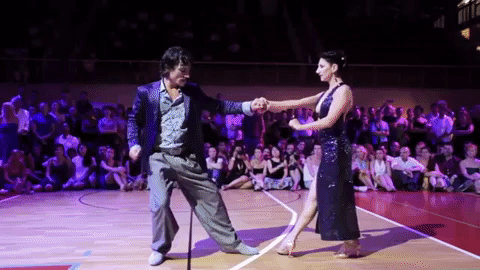Your best tango will happen when you connect the basic “three”

I have always thought I have good musicality. For years, I’ve been dancing in international high-level events and always got compliments on my musicality and playfulness. As a kid, I studied music, composition and spent years playing an instrument. I attended some musicality classes but never connected to them, I always thought they were too basic. Phrase, melody, beat… Dancing to different orchestras. I often didn’t see the point in studying that. It didn’t change my dance for me. But mainly, my partners’ praise got me thinking high of myself.
That is, until I went to my first workshop with Horacio Godoy a few years back. That man turned my music view upside down and on its head. And he didn’t even cover anything “advanced”, it was all very simple and understandable. Beside being perhaps the most energizing teacher I have ever encountered, it was obvious he had mountains of knowledge in his head and body, like a walking-talking-dancing encyclopaedia. And I understood I had no idea about music. I felt it, I danced to it, but I had no real idea. Why is the music doing this, and not that? Why do we choose this part to dance to, subconsciously, and not that? What drives us to respond in the ways we do? Are there ways to become more interesting, more deeply connected to the music?
When you ask people what brought them into tango, sooner or later you will hear the following answer: “I heard tango music and really liked it, so I wanted to dance to that”. That wasn’t my own motivation, and I have always found this answer a bit perplexing and mysterious. Maybe I was too young or hectic, or maybe just too non-argentinian to understand the value of this music. As a large number of dancers around the world, I wanted to move. Tango gave me an opportunity to move beautifully, with a partner, connected, and music came as a nice bonus.
Now I think differently. I believe music should drive our movement, facilitate our connection, provide the safe space for experimentation. I feel it urgently when we as a couple move, but do it without letting the music move us. And I started teaching differently now. More and more effort goes into making students move “behind” music, so they have time to make up their minds on what they want to do with that music, and communicate it to their partner.
Three main elements of tango
I created a system of “threes” in tango, to try to understand tango myself and explain it to others. Connection consists of three elements, same as what leaders’ role is, and what followers do as well. It’s easy to think of complex things in sets of “three elements”, each time going deeper into the next level of “threes”.
And the most basic “three” is connection in tango: you need a leader, a follower and music to unite them. Once one of the elements is out, tango is lost. If you are an excellent skilled leader and you know music well, but you don’t pay enough attention to the deeper expression and beauty of the movement and personality of your follower, you are not dancing tango. Or if you are together, well connected, respecting each other and listening to each other, but you don’t put enough care to what music does to you, and you dance independently of the mood, the energy, the story of the music, then you’re maybe doing couple meditation / contact improvisation with tango steps, but you’re not dancing tango. Or maybe you are a follower who deeply feels music but you are frustrated that your leader doesn’t feel it the same way as you do, and you choose to “override” the lead on too many occasions, too aggressively, losing the gentle balance that we need to be connected with our partner.
I have been in each one those situations myself, and I am sure you are familiar with them as well. As I was younger, I ignored music most of the time. Not really in the “off beat” kind of sense, but I often didn’t mind whichever music with whichever partners. On the other hand, I had also been dancing professionally with someone who was good and knew music, but didn’t connect to me, so the dance was not about connection but about his personal expression. And I’m definitely guilty of sometimes trying too hard to express music by myself, despite my partner not feeling the music the similar way, and maybe even questioning my choices of expressions.
We can’t be perfect, and we shouldn’t try to be. Perfection kills fun. But we should definitely strive to be better. BETTER is a great way of motivating ourselves, of setting goals. One important aspect of BETTER is not better than someone else, but better than we are now. Don’t try to compare yourselves to others, that will only bring you frustration and unhappiness. Get better than you are now.
So I invite you to get better at connecting and creating tango: better at being an attuned leader or follower, and better at listening and including music into your dance. And then push it further. The next step is difficult, and does require study: get better at letting the music inspire your dance, your togetherness. Learn to let the music carry you, stop and start you, empower you. Your best tango will be when you have those three simple and such difficult elements right:
Music, Leader and Follower. All together, attuned, open, listening to each other, inspiring each other.
Enjoy!
With love for tango,
Olga Metzner
Cover photo by Thibault Cresp Photographie





















